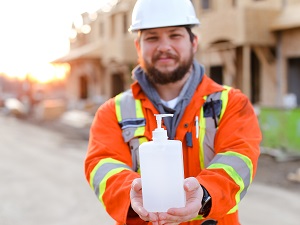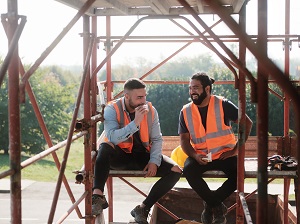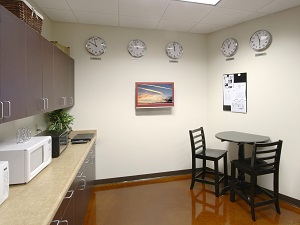Personal hygiene should not interfere with anyone’s ability to complete their job as effectively, and safely, as expected. When employees report for work, they have a right to a clean and safe workplace.

Every workplace has a hygiene standard that demonstrates the values of the organization. When employees exhibit good personal hygiene at work, this helps:
- promote good health and well-being for all personnel.
- prevent the spread of illness.
- limit distractions and safety concerns due to poor hygiene and housekeeping issues.
- set a good example for others.
- provide an atmosphere of cleanliness, orderliness and safety.
- make the workplace more pleasant for others.
- reduce stress due to tension among employees who have different opinions on personal hygiene and job site cleanliness.
Reminders concerning personal hygiene, and why it's important as part of your workplace safety program, can be provided as a topic during a safety meeting or toolbox talk. Areas of guidance that you can bring up during the safety meeting include clothing, PPE, cleanliness, odor, hand washing, eating and keeping common areas clean.
If you aren't sure how to approach the subject or what areas are important to concentrate on, here are some good tips on reminders you can provide to your crews during the safety meeting.

CLOTHING
Keep your work clothes clean and in good condition. Holes in clothing increase the likelihood that hazardous or contaminated substances may come in contact with your skin that may cause irritation. Ripped clothing, or clothes that do not fit properly, may pose a caught-in hazard when working around machinery. Wash dirty or soiled clothing before wearing again.
If you work in a wet environment, change your shoes every other day to give them time to dry out. Clean dirt and debris off of work boots regularly.
Do not wear PPE that is damaged, torn, worn out or excessively dirty. Store PPE in a clean and dry area, until required for use, to prevent contamination. Do not reuse single-use PPE like one-time use face masks or disposable gloves. Do not touch contaminated PPE with your bare hands.

BODY HYGIENE
It may not bother an individual to have less than ideal personal hygiene, but when in a working environment it can have an impact on other personnel. When odors become a problem, they can affect co-workers’ ability to concentrate on their own tasks on the job.
Bathe, shower and wash your hair regularly. Use soap to bathe. Use deodorant or antiperspirant daily, especially if you tend to sweat during the course of the work day.
Keep your hands neat and clean. Wash your hands often. Never use solvents to clean your hands.
Avoid wearing too much perfume or cologne. Some people may have allergies and the strong scent may be irritating. Perfume, cologne, and scented lotions should be kept to a minimum while at work.
Maintain your dental health. Bad breath may not be apparent to you, but it can be offensive to other workers.
Wear clean socks to work each day. Cotton socks are best because they “breathe” and absorb moisture.
Cuts and burns must be covered at all times with appropriate first aid dressings. Make sure cuts, burns or lacerations are kept clean to prevent infection.

ILLNESS PREVENTION
Do not come to work if you are feeling sick.
Cover your mouth when you sneeze or cough, with your hand, with a tissue, or with the inside of your elbow. Always wash your hands afterwards. Throw away used tissues immediately.
Wash your hands with soap and water (not just water). If soap is not available then use a hand sanitizer that is at least 60% alcohol.
Always wash your hands…
- before and after your work shift.
- after visiting the restroom.
- before and after wearing gloves.
- if your hands become dirty or come in contact with hazardous or contaminated substances.
- after sneezing or coughing into your hands or a tissue
- before and after eating
- after handling trash or after any cleanup activity
- after handling money
- after touching dirty equipment

WORK AREA CLEANLINESS
Keep your work area tidy, and clean up after yourself, including after using the restroom or any other common areas. Throw away garbage, wipe down surfaces, and pick up anything that fell on the floor or the ground. Throw away trash at the end of your work shift that may have accumulated throughout the day, including food wrappers, used paper towels or tissues, beverage containers, etc.
Do not keep any food at work that is not in a sealed container. Throw away any uneaten food, that is kept at work or in a work fridge, at the end of every week. Wash reusable dishes daily, including mugs, insulated thermos containers and utensils.
OSHA Standard 1926.25(c) Containers shall be provided for the collection and separation of waste, trash, oily and used rags, and other refuse. Containers used for garbage and other oily, flammable, or hazardous wastes, such as caustics, acids, harmful dusts, etc. shall be equipped with covers. Garbage and other waste shall be disposed of at frequent and regular intervals.
Use garbage cans and do not litter. Trash bins should be emptied regularly and not allowed to overflow. Trash should never be spilling onto the floor.
Wipe down the microwave after using. Always place a paper towel, paper plate or other cover on the top of any food cooking in a microwave to prevent splatter.
If you notice ants, vermin, or droppings in any work or common area, notify management immediately.
OSHA Standard 1910.141(a)(4)(ii) All sweepings, solid or liquid wastes, refuse, and garbage shall be removed in such a manner as to avoid creating a menace to health and as often as necessary or appropriate to maintain the place of employment in a sanitary condition.


.jpeg)

.jpg)
.jpg)